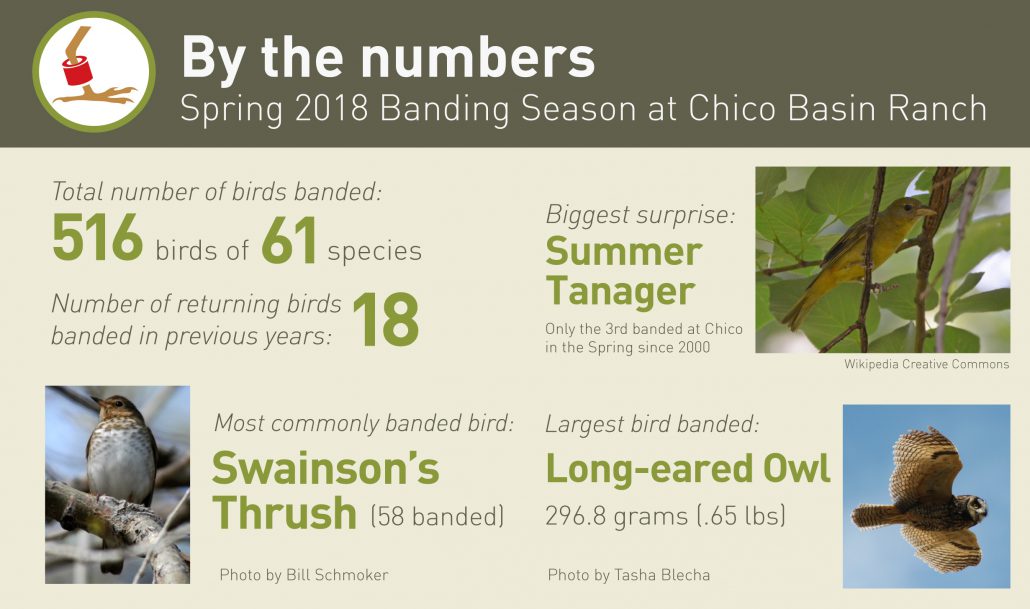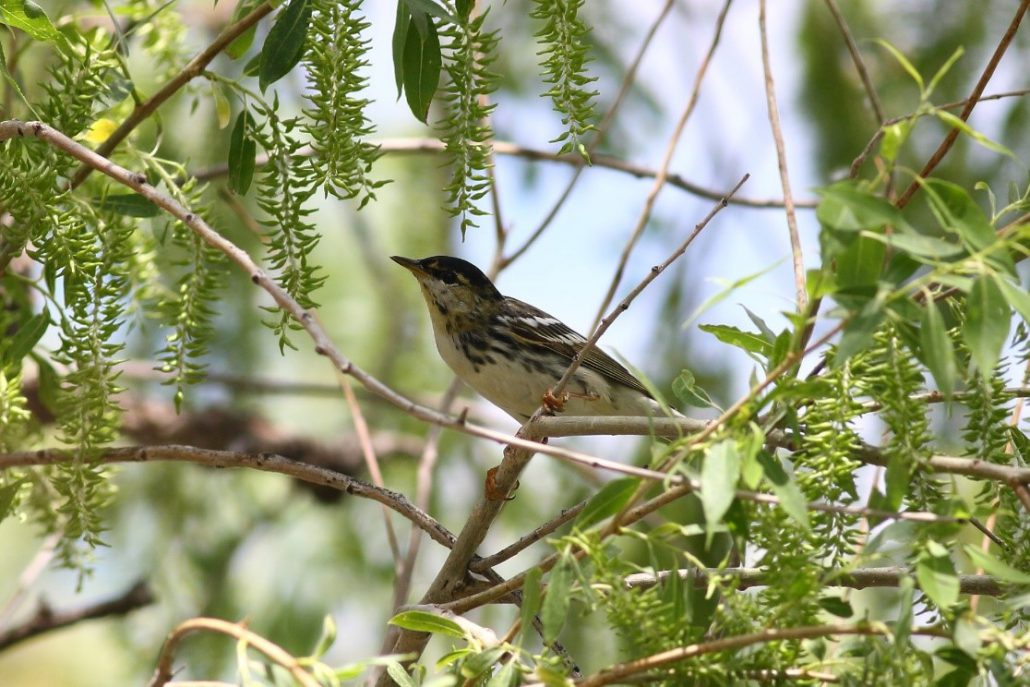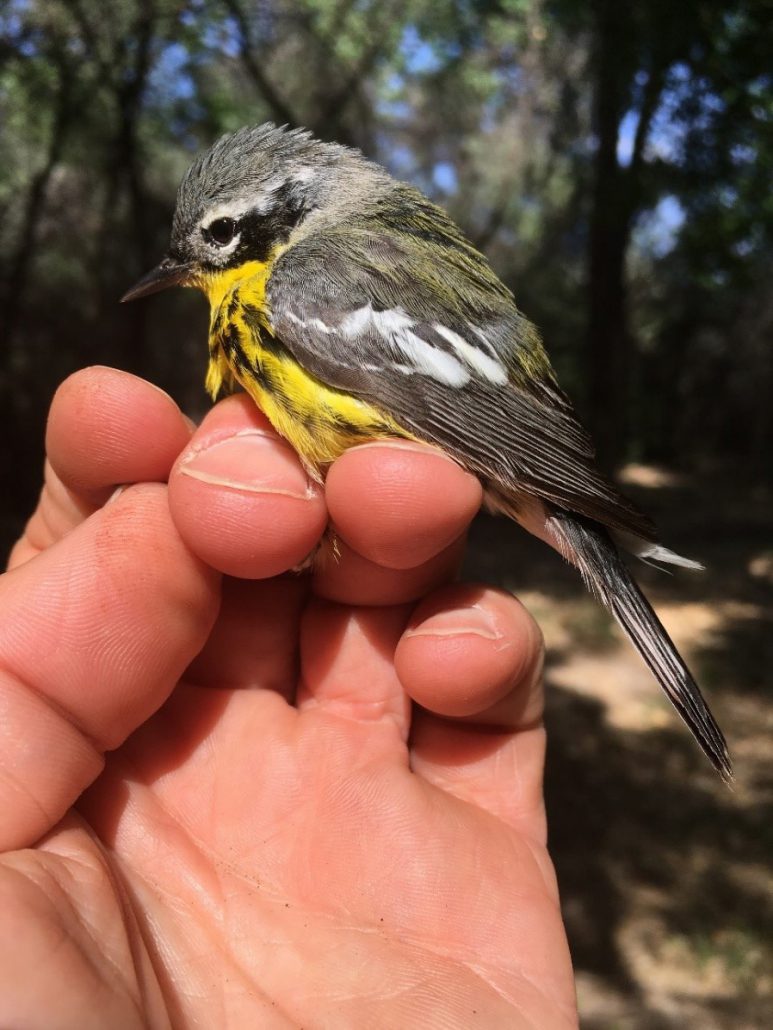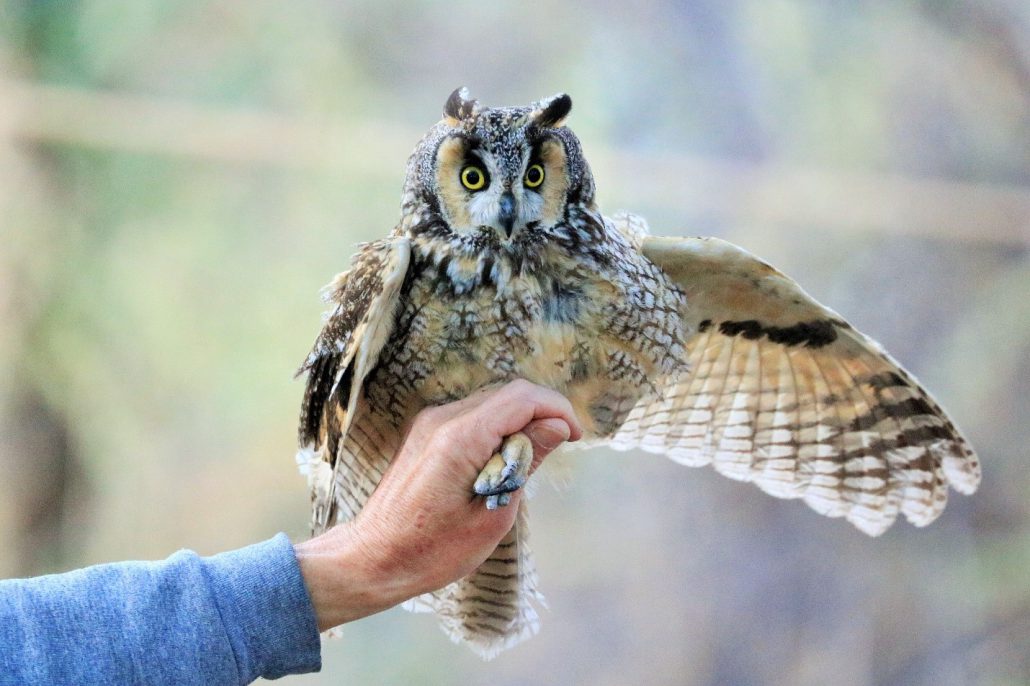
Colorado’s Chico Basin Ranch continues to be a home and haven for migratory and resident birds.
2018 marked the 19th consecutive spring season of bird banding at Chico Basin Ranch, southeast of Colorado Springs, CO. Bird Conservancy of the Rockies operates this banding station in partnership with Ranchlands Learning and Research Center. Chico Basin Ranch is a special place; an oasis of wetlands and wooded areas surrounded by otherwise very arid cholla grasslands. The thick-wooded groves are a magnet for north-bound migratory birds, offering a cornucopia of energy-rich invertebrates to fuel the birds’ long-distance flights.

A male Blackpoll Warbler sighted in a willow grove at Chico Basin Ranch this Spring. Though we didn’t band any this season, eighteen Blackpoll Warblers have been banded in previous Spring seasons. Photo by Colin Woolley.
The Chico, as it is known to the ranchers that live and work there, is geographically positioned to play host to species that are typically found further east. A whopping 31 species of warblers have been banded here over the years. The Chico also sits near the northern limit of several desert-associated species, such as Ladder-backed Woodpecker and Curve-billed Thrasher. A spring morning spent in the wooded groves of the Chico is filled with anticipation; wondering what unusual bird may show up next. Perhaps you’ll catch a glimpse of a colorful eastern warbler or vireo. Are you an experienced birder that enjoys puzzling over Empidonax flycatchers? Eight species of Empidonax have been banded here. Raptors abound as well, with banding records of Broad-winged Hawk, Long-eared Owl, Flammulated Owl as well as the more commonly encountered Cooper’s and Sharp-shinned Hawks. Chico Basin Ranch’s bird list sits at over 330 species, putting it among the most diverse of birding sites in Colorado.

We banded a second-year male Magnolia Warbler this spring, just one of the 31 species of warblers that have been banded at Chico Basin Ranch. Photo by Ken Burton.
Our banding stations provide a unique opportunity for students and the general public to see birds up close and learn about bird conservation, migration, and the importance of migratory stopover sites such as the Chico. At the station, mist nets are used to catch birds without harming them. Once caught, a small metal band is placed on the bird’s leg. Each band is numbered, so when a bird is recaptured scientists will know when and where it was banded. The bird’s condition is checked and weight and measurements recorded. This spring, over 500 K-12 students from the area made the trip out to the ranch to visit the banding station and learn about why and how we study birds.

Our largest banded bird of the season, a Long-eared Owl weighing in at 296.8 grams. Long-eared Owls regularly roost in the wooded groves at Chico Basin Ranch. Photo by Risë Foster-Bruder.
It’s no accident that birds regard the Chico as a sanctuary, and it’s not just because of geography. The Chico has made the environment and sustainability a cornerstone of its management. A thoughtful, deliberate approach enables this working cattle ranch to operate successfully, contributing to the local economy while simultaneously preserving a beautiful landscape of wide open spaces. Ranch managers pay close attention to the plant and animal communities that live there, as well as things like water management, mineral cycles, energy flow, and grazing methods. As indicators of landscape health, birds are great at telling us about conditions on the ground. Information gleaned from bird banding generates long-term data that informs conservation action and land management decisions. Monitoring enables ranchers to understand what is happening, adapt and adjust where necessary, and learn which strategies are succeeding in furthering their goals.
In years past, Bird Conservancy has worked with land managers at Chico Basin, along with the Wildlands Restoration Volunteers and 50 volunteers, on significant restoration efforts on the ranch. The work was made possible with funding from Colorado Parks and Wildlife Wetlands Program. The project involved removal of many Russian olive and tamarisk trees, invasive plants that negatively affect the health of wetlands and riparian areas. Volunteers subsequently planted 1,273 native shrubs such as choke cherry, wild plumb, and service berry – species that were chosen because they provide good habitat for resident and migrant birds. Fenced areas were also constructed to protect over 200 cottonwoods and thousands of willows. These habitat enhancements are in close proximity to where our bird banding station is located today.
 Visit Chico Basin Ranch
Visit Chico Basin Ranch
Our upcoming fall banding season at Chico Basin Ranch will run from September 5th through October 5th. The banding station is open to the public and all are welcome to visit and learn about bird banding and identification. There is a $15 per person fee to access the private ranch. For larger groups or to schedule an educational program, contact [email protected].
For more information on Bird Conservancy’s bird banding program and stations, visit our website or contact Colin Woolley (Banding Coordinator) via e-mail or by phone: 303-659-4348 x15


